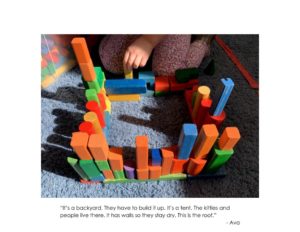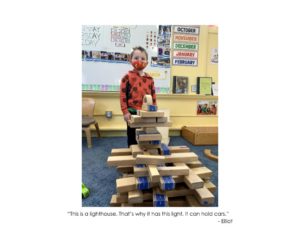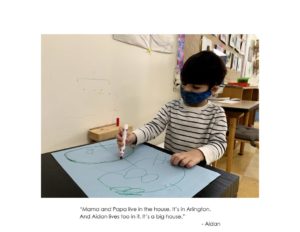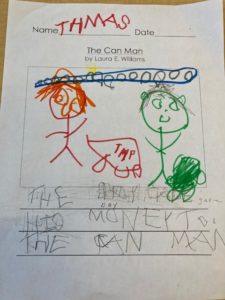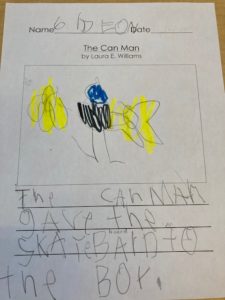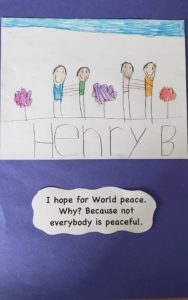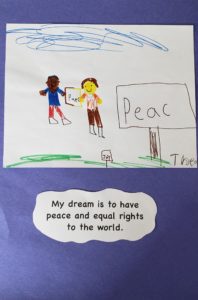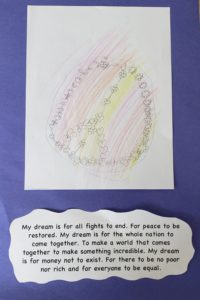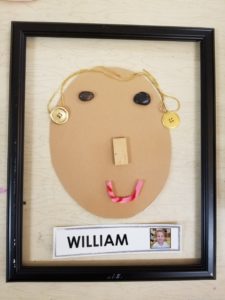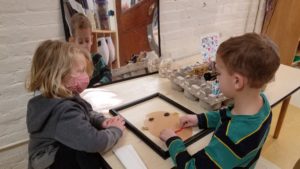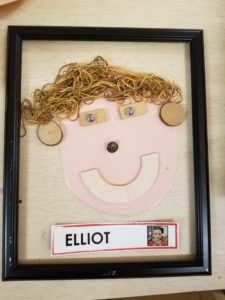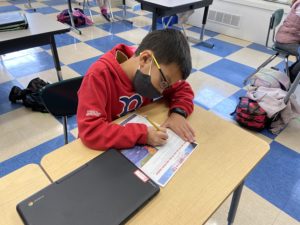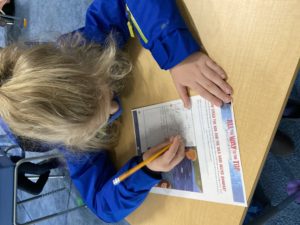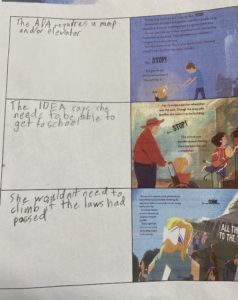In this space we highlight various anti-bias activities and initiatives that our students are involved in. This page will be updated regularly so check back often and see what we’re up to!
Purple Room Students Learn to See the World from Many Perspectives
This year our curriculum has been strongly focused on social-emotional development, such as how to use flexible thinking, understanding and recognizing feelings, and building healthy interpersonal connections. Our latest topic is the word perspective, and what it means to try and view the world through the eyes of others.
Our journey began with a literal definition of the word. After reading Brendan Wenzel’s They All Saw a Cat, children learned that perspective means a literal difference in what or how you see. We then introduced several activities which reinforced this concept, like viewing an optical illusion of a duck/rabbit to understand that different perspectives can co-exist, and playing a game where children had to describe objects in the room that were outside their friends’ views.
Recently, we also finished a special self-portrait activity. As children looked in mirrors to draw images of themselves, one of their peers sat by the side and also drew a portrait of that child. Once these were finished, we gathered together to look at the images side-by-side. Even at this early age, it is natural for children to notice physical differences such as skin tone and the size/shape of facial features. What made this conversation special, however, 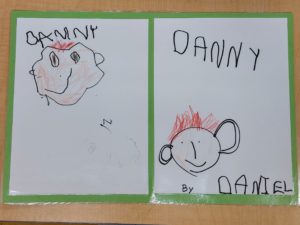 is that it helped children think about their appearance from two perspectives at the same time. They reflected on the differences between how they view themselves compared to how others might view them. Some observations included:
is that it helped children think about their appearance from two perspectives at the same time. They reflected on the differences between how they view themselves compared to how others might view them. Some observations included:
- “Her eyes are bigger than the ones I drew.”
- “In her picture I have black hair, but I don’t have black hair. I have brown hair. She also added brown and some red.”
- “He drew my arms very strong, but I drew my arms squiggly.”
- “Sometimes their skin has two colors at the same time.”
This is only the beginning, of course, of a much larger conversation about what makes each of us unique. Over the coming weeks, the Purple Room will continue thinking about perspective, as well as the ways that we are all different and similar. Ultimately, our goal is to connect the word to a wider cultural mindset that grows from classroom to community to planet.
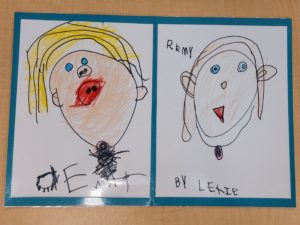 |
 |
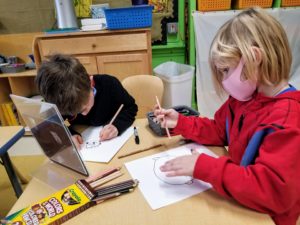 |
Middle School Students Explore Rise in Anti-Asian Hate
In April, seventh-graders did a month-long unit on the Asian-American experience, and the recent uptick in anti-Asian hate and violence. We began with a PBS Newshour report on the surge of violence in San Francisco. Students then broke into groups to read article on topics ranging from:
- a personal account of violence by one victim,
- the concept of Asians as a “model minority,”
- the notion that the term “Asian” includes a multitude of cultures, languages, and immigration experiences; and
- the ways that laws and policies have served to drive a wedge between black and Asian communities in America.
Groups of students presented the articles they had read to the whole class so that everyone could benefit from what they had learned. In addition to these articles, we watched: a video series on Chinese food in America; a video that used a TV sitcom set-up to discuss the ways the U.S. government “created” the image of Asian-Americans as a model minority; and–for National Poetry Month–listened to ‘Today, I Am A Witness To Change,’ a crowdsourced poem against anti-Asian hate compiled and edited by NPR’s resident poet Kwame Alexander. Students reflected on what they learned during the unit using a Square/Triangle/Circle format where each student was asked to describe four things that they learned that squared with their thinking (that they agreed with, or knew already), three things that changed the way they see the world, and one question still circling in their mind. Here are some examples of what they wrote:
SQUARE |
TRIANGLE |
CIRCLE |
|
Four things that square with your thinking. |
Three things that cause you to look at the world in a different way. |
One question still circling in your mind. |
|
|
|
To close the unit, students wrote informal, journal-format reflections. Here are the thoughts of one student:
I think that Asian-American hate is horrible. Learning about how people are affected based on their race, looks, or culture is interesting and sometimes hard to hear. Humans should be respectful of each other and learn from other people. I connect Asian-American and black hate with World War II. Having a “superior race” is just another step into dehumanization which leads to horrible actions and hate. We, as humans, need to accept new people and cultures that are around us. Everyone is different and that shouldn’t be a bad thing. When jobs, family, and life is affected by your looks or beliefs the choice shouldn’t have to be changing. I have learned that people are separated into categories that define us to others before anyone knows anything about you. Is this how the world is and will be in the future? As the next generation, I choose to fight for equality and work to stop making people fit into categories.
Early Childhood Students Practice Visual Thinking
We have been weaving in our anti-bias topics throughout the course of our days over the past months in the Orange Room. Children in our classroom frequently do an activity called Visual Thinking. During this time, children sit in small groups and spend time looking at a picture and sharing their ideas about things they notice. When we all slow down and take a significant amount of time to look at one image, then to listen to each other’s observations, it sometimes makes us notice things we may have originally glanced over. For two of our recent Visual Thinking activities, we used pictures from two of our favorite books with anti-bias topics: Most Days by Michael Leannah and Last Stop on Market Street by Matt De La Pena. These two books both feature characters from a variety of backgrounds and children made thoughtful comments about what they were looking at, noting different skin colors, clothing, and emotions. Some comments kids made included:
“Someone looks like they have cinnamon skin.”
“ There is a person who looks like he has a mad face.”
“Most people are happy and someone may be blind.”
“There is a symbol for where wheelchairs can go.”
In addition to these activities, we have had discussions about books such as The Proudest Blue: A Story of Hijab and Family by Ibtihaj Muhammad and All the Colors We Are : the story of how we get our skin color = Todos los Colores de Nuestra Piel : la historia de por qué tenemos diferentes colores de piel by Katie Kissinger.
Our Youngest Learners Explore Being Kind and Understanding One Another
In Early Childhood, one of the most important things that children work on is building relationships. They learn how to share, how 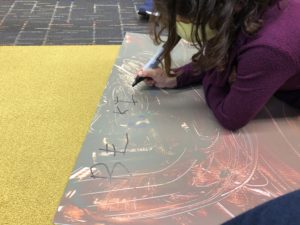 to take turns, and how to negotiate and problem-solve. Preschool and PreK are often a child’s first experience with spending time among other children, away from their parents. We focus a lot on being kind to one another, learning to see another person’s perspective, and making sure that everyone has what they need, even if it isn’t always what they want.
to take turns, and how to negotiate and problem-solve. Preschool and PreK are often a child’s first experience with spending time among other children, away from their parents. We focus a lot on being kind to one another, learning to see another person’s perspective, and making sure that everyone has what they need, even if it isn’t always what they want.
During our walks around the school in September, the students in the Blue Room spent a lot of time looking at signs that other children and teachers had decorated to show support for everyone in the community, but particularly for Black and Brown families. We used that as a starting point to recognize and celebrate our many differences, from skin color to family make-up to abilities. We have learned about one another’s cultures and spent some time reading stories about cultures that are not represented in our classroom. Most of all, the children worked on strengthening existing relationships and developing friendships with students who were new to Lesley Ellis. We had several new students join us in February and March, and the Blue Room students were excited to welcome them into our classroom 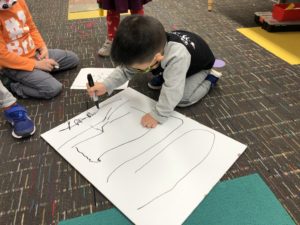 community.
community.
At the end of March, we invited the students in our classroom to create their own signs to display around the school. After working together to paint the signs, children created and wrote their own messages, which focused on friendship and inclusion:
“Be nice to us”
“Be kind”
“Be kind to people”
“Don’t hurt anybody”
“Be good”
“Make friends”
“Stop and read”
“Blue Room”
“Play with me!”
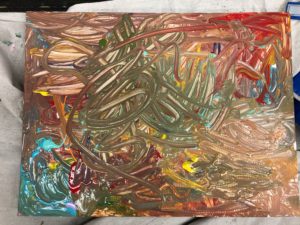
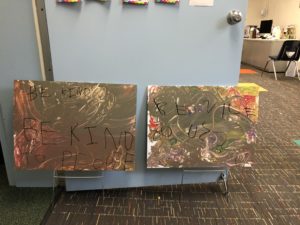
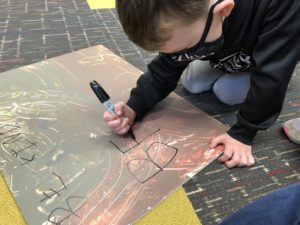
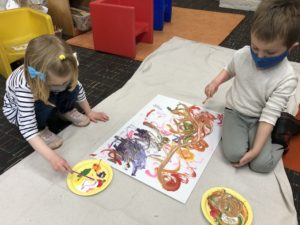
Early Childhood Students Learn About Homes Around the World
Throughout their building and play, the preschoolers have been investigating the many different ways to create houses and shelters. Their investigation has led them to discover that houses can have many different attributes, such as big, small, tall, and short.
After reading Home by Carson Ellis, Homes in Many Cultures by Heather Adamson, and Houses and Homes by Ann Morris, the preschoolers discussed the similarities and differences between their houses and the houses from around the world pictured in the books. We then had a thoughtful discussion about all the things that homes do for people – we sleep, eat, and play in our houses. We also love and are loved by the people in our homes!
Some children then took these ideas to heart in both their building and drawings. They looked at the pictures from homes around the world, and worked on creating houses that looked both similar to their current homes and to those elsewhere in the world.
Kindergartners Explore Ways to Help Others
In kindergarten we often use books as a way to facilitate anti-bias discussions, including how economic differences affect people’s lives. In the book, The Can Man, Tim wants a skateboard for his birthday. He knows his family is not able to afford a skateboard and looks for ways to earn the money. He sees the Can Man looking through trash for cans to cash in for the redemption money. Tim decides to collect cans too, hoping to collect enough money for the skateboard. When Tim learns The Can Man is collecting cans to buy a new winter coat, he decides to give the money to the Can Man. The book led to a discussion about homelessness and how we can help others. The kindergartners offered a number of suggestions, including donating food, clothing, and toys. We have also read A Rose for Abby and Maddi’s Fridge, about food uncertainty and discussed ways we can help others.
Second Graders Study Martin Luther King Jr.
During the month of January, the second graders have been looking at the life and legacy of Dr. Martin Luther King Jr. We read the stories Happy Birthday Martin Luther King and I have a Dream. While engaged in group discussions, many students connected Dr. King’s message with the Black Lives Matter movement and how even after all these years, there is still so much work to be done when it comes to justice and equality. Inspired by Dr. King’s work, second graders thought about topics that were important to them. Then they shared the different ways that they could make positive changes for themselves, their family, the community, or the world.
Below is a sampling of some of their hopes and dreams.
Early Childhood Students Create Self-Portraits
An important part of Early Childhood development is understanding differences. This includes not only cultural differences, but physical ones as well. Each year the Purple Room creates self-portraits to help children think about physical features. Using mirrors, they examine their faces and recreate them using markers, pencils, paint, and other mediums.
This month, we used loose parts to create images of ourselves. Children started by choosing an oval piece of paper which best represented the shade of their skin. Teachers then guided them to think about the color, texture and shape of their features. Children could choose from a selection of objects, including yarn, buttons, gears, wood pieces, and hardware bits. In choosing these loose parts, children thought about similarities and differences. Though many children used buttons for eyes, for example, they observed how colors, shapes and details were always unique. Awareness and open-mindedness are the foundation for larger conversations about bias and diversity.
Sixth Graders Address Racism
Our Grade 6 students banded together to create a slideshow of ways they are personally combating racism and sharing ideas for others to do the same. Given the racial justice work individuals all over the country are committing to in the wake of white supremacist violence, our students are joining the efforts being made to become more anti-racist and show ally-ship to marginalized communities. They have learned that one person really can make a difference, and that if everyone comes together to do the work, then we can move toward a more equitable future!
|
|
|
Click the link below to see the pdf slide show that our students put together:
Grade 1 Students Learn About Ableism
Does the Lesley Ellis School provide reasonable access to the building for people who use a wheelchair, walker, braces, or crutches? Grade 1 students in Barbara’s class asked themselves this question recently as they delved into the topic of ableism. 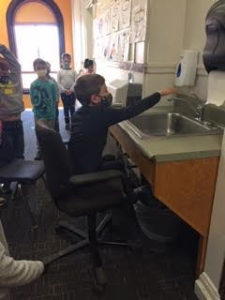
We started our trek at the outside of the building and realized that the Oxford Street entrance had an elevator that reached the lower and first levels. On the first level, we found the stair elevator that would take us to the second floor, where our classroom is located. Using a mock chair to simulate a wheelchair, we could negotiate to move around in our room. We also realized that it would be challenging for a wheelchair to get to the loft’s top part. We had lots of exciting adaptations we could make to the loft, such as a long ramp. Finally, we rolled out into the hall, where we could use the sink to wash our hands and get water. However, the soap and paper towel dispenser would need to be relocated. Off to the bathroom, we found a wide door stall with railings next to the toilet that accommodated our wheelchair easily. Included in the stall was a sink.
Overall, we were happy to find that most of the school building was accessible to people who used wheelchairs, braces, walkers, and crutches. We are continuing this in-depth look at our school building’s ability to meet all its members’ needs as we look at other physical challenges.
Kindergartners Explore Stereotypes 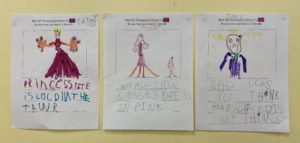
In kindergarten we try to base many of our anti-bias lessons on excellent books, and often the students work on “reader’s response” projects to draw and write about the subjects which the books make the students think about. We’ve read a number of excellent books in the last months.
Julian is a Mermaid is about a boy who is wholeheartedly accepted by his grandmother when he chooses to dress in a style that does not fit his gender’s stereotypical style. Maddi’s Fridge is about economic diversity and how friends help each other in tough situations. Not All Princesses Dress in Pink was preceded by a discussion of “real princesses” and “fairy tale princesses” and a discussion of the word “stereotype.”
When the associated press called the election for the Biden/Harris ticket, we discussed the graphic that showed Kamala Harris’ body creating the shadow of Ruby Bridges, from the famous painting by Norman Rockwell. Then we read the excellent The Ruby Bridges Story about the first grader who was one of the first to be integrated into a school in the American south. We also discussed the many firsts for Harris, as a woman of Indian and Jamaican heritage.
Third and Fourth Graders Learn About the ADA
Explore what it means to be an active ally
Become the change waiting to happen – become an active ally! Within each cohort of third and fourth graders, we came one step closer by uniting hearts and minds, brainstorming various ways we could all shift our view of the world and others around us.
Together, we read the story, All the Way to the Top by Annette Bay Pimentel, with forward by Jennifer Keelen-Chaffins, which outlines the struggles of a young girl who has cerebral palsy and becomes a young voice and activist in the Disability Rights Movement.
From this, we moved on to studying the American Disabilities Act, which celebrated their 30th anniversary this summer, and had in-depth discussions about the protections and rights that this law outlines for the over 60 million Americans that live with disabilities.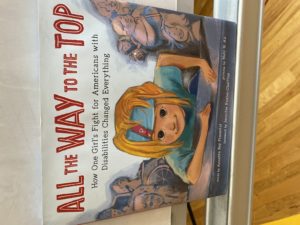
Students then examined the illustrations from the text to identify the challenges that Americans with disabilities faced prior to 1990 when ADA was implemented. Though the ADA aided in opening opportunities for those with disabilities, we also recognize that there is still work to be done.
In 3/4 we may be young, but much like Jennifer Keelan-Chaffin, we have a powerful voice that can make change and be used to be an active ally.
The Harriet Tubman Question
Middle School students read one of two articles from opposing views about whether or not Harriet Tubman should be put on the $20 bill. Each student then crafted an argument composed of an assertion, reasoning, and evidence to support the viewpoint expressed in the article that they read (not necessarily their own opinion). Afterwards, students posted their arguments to Google Classroom and had an opportunity to read and respond to each other’s arguments. Many students were surprised to find that their opinions had been changed by the arguments of their peers. Here are examples of arguments that students posted:
Harriet Tubman should be on the 20 dollar bill because we need to recognize what we did. One reason we need this is because money is how we recognize important people and the important things they did in our community. Harriet Tubman did many great things but it feels like we are almost saying , “We don’t care.” Another reason is that many children look up to Tubman and having her on the bill shows them that she did great things and deserves to be looked up to. This is why she should be on the bill.
I think that Harriet Tubman should not be featured on the $20 bill. In a society that used to treat Black persons as goods rather than people, it seems wrong to make a picture of one our currency. This image seems to convey that they are only useful for their labor. According to a study of a 2020 Racial wage gap, a black woman gets paid $0.972 for every dollar a white man makes. So until pay is given equally, then we shouldn’t include someone who represents the abolishment of slavery and rascism. Because it still happens.
Harriet Tubman shouldn’t be on the 20 dollar bill because it is not as important, and kind of disrespectful. But instead she should be a part of something like the “Harriet Tubman Reparations Act or the Harriet Tubman Abolition of Prisons Act,” which seems more respectful.
Harriet Tubman should be on the 20$ bill. Having a woman, person of color, or both on a dollar bill is a long awaited and important time in history. As Underground Railroad conductor and soldier and spy for the Union Army during the Civil War. The proposition of Harriet Tubman on the bill was meant to coincide with the 100th anniversary of the ratification of the 19th Amendment, which granted some women the right to vote. Also, having a white man and slave owner as the position on the bill (President Andrew Jackson) will not produce positive role models or ideas. Sen. Shaheen, a large advocate for Harriet on the bill and she says, “Our paper currency is how we measure value in our society, and the fact that we haven’t had any women on our paper currency is a suggestion that we don’t value the contributions of women in the way that we should,” This shows that we as a society need to have more diverse and equal ideas completed.
Did any of these arguments change your mind? Did they at least make you think about the issue differently? Us, too!
